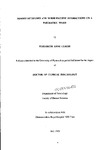NURSES' ATTITUDES AND NURSE-PATIENT INTERACTIONS ON A PAEDIATRIC WARD
| dc.contributor.author | CURTIS, ELIZABETH ANNE | |
| dc.contributor.other | School of Psychology | en_US |
| dc.date.accessioned | 2013-10-24T09:20:35Z | |
| dc.date.available | 2013-10-24T09:20:35Z | |
| dc.date.issued | 1995 | |
| dc.identifier | NOT AVAILABLE | en_US |
| dc.identifier.uri | http://hdl.handle.net/10026.1/2336 | |
| dc.description.abstract |
Despite the potentially very significant role of nurses in mitigating against the negative effects of hospitalisation on children, the attitudes and behaviour of paediatric nurses towards patients have been largely ignored within the literature. This study, therefore, aimed to consider paediatric nurses' attitudes and their interactions with patients and, in particular, to investigate the relationship between these two variables. However, in contrast with similar studies in other specialties, nurses' attitudes and behaviour were considered at a general and individual patient level. A general attitude measure, the Paediatric Attitude Scale (PAS), was developed during the first part of the study and indicated that nurses' attitudes towards patients as a whole tended to be tolerant and patient-centred. Nurses' interactions with patients were mainly positive and, in contrast with previous research, regularly occurred outside of the normal nursing routine. In addition, almost half of all nurse-patient interactions contained a social component. As predicted, no significant association was evident between nurses' scores on the PAS and their general behaviour with patients. However, modest associations with correlation ratios of between 0.10 and 0.16 were found between nurses' attitudes towards individual patients (as measured by ranking scales) and the quality, duration and, to a lesser extent, the number of interactions with those particular patients. Indeed, the results suggested that patients who were liked more and who were considered easier to nurse tended to receive interactions which were more positive and longer than patients who were liked less and who were perceived to be more 'difficult'. However, the actual differences between interaction scores for particular patients were relatively small and their clinical significance in terms of the impact on children and the need to modify nursing practice is, therefore, debatable. | en_US |
| dc.description.sponsorship | Gloucestershire Royal Hospital NHS Trust | en_US |
| dc.language.iso | en | en_US |
| dc.publisher | University of Plymouth | en_US |
| dc.title | NURSES' ATTITUDES AND NURSE-PATIENT INTERACTIONS ON A PAEDIATRIC WARD | en_US |
| dc.type | Thesis | |
| dc.identifier.doi | http://dx.doi.org/10.24382/4074 | |
| dc.identifier.doi | http://dx.doi.org/10.24382/4074 |
Files in this item
This item appears in the following Collection(s)
-
01 Research Theses Main Collection
Research Theses Main


